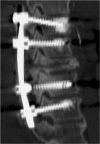Complications in minimally invasive percutaneous fixation of thoracic and lumbar spine fractures and tumors
- PMID: 24057199
- PMCID: PMC3830034
- DOI: 10.1007/s00586-013-3019-7
Complications in minimally invasive percutaneous fixation of thoracic and lumbar spine fractures and tumors
Abstract
Purpose: We propose to evaluate the complication rate in minimally invasive stabilization (MIS) for spine fractures and tumors, as a common alternative to open fusion and conservative treatment.
Methods: From 2000 to 2010, 187 patients were treated by minimally invasive percutaneous fixation in 133 traumatic fractures and 54 primitive and/or secondary spine tumors. Complications were classified, according to the period of onset as intraoperative and postoperative, and according to the severity, as major and minor.
Results: A total of 15 complications (8 %) were recorded: 5 intraoperative (3 %), 6 early postoperative (3 %) and 4 late postoperative (2 %); 6 were minor complications (3 %) and 9 were major complications (5 %).
Conclusions: Minimally invasive stabilization of selected spine pathologies appears to be a safe technique with low complication rate and high patient satisfaction. MIS reduces hospitalization and allows a fast functional recovery improving the quality of life.
Figures




Similar articles
-
Minimally invasive percutaneous fixation in the treatment of thoracic and lumbar spine fractures.Eur Spine J. 2009 Jun;18 Suppl 1(Suppl 1):71-4. doi: 10.1007/s00586-009-0989-6. Epub 2009 Apr 28. Eur Spine J. 2009. PMID: 19399533 Free PMC article.
-
Complication rates associated with open versus percutaneous pedicle screw instrumentation among patients undergoing minimally invasive interbody fusion for adult spinal deformity.Neurosurg Focus. 2017 Dec;43(6):E7. doi: 10.3171/2017.8.FOCUS17479. Neurosurg Focus. 2017. PMID: 29191098
-
Incidence and Risk Factors for Facet Joint Violation in Open Versus Minimally Invasive Procedures During Pedicle Screw Placement in Patients with Trauma.World Neurosurg. 2018 Apr;112:e711-e718. doi: 10.1016/j.wneu.2018.01.138. Epub 2018 Jan 31. World Neurosurg. 2018. PMID: 29391300
-
Minimally invasive resection of extradural dumbbell tumors of thoracic spine: surgical techniques and literature review.Eur Spine J. 2016 Dec;25(12):4108-4115. doi: 10.1007/s00586-016-4677-z. Epub 2016 Jul 1. Eur Spine J. 2016. PMID: 27371333 Review.
-
Comparison of Minimally Invasive Total versus Subtotal Resection of Spinal Tumors: A Systematic Review and Meta-Analysis.World Neurosurg. 2021 Jul;151:e343-e354. doi: 10.1016/j.wneu.2021.04.045. Epub 2021 Apr 19. World Neurosurg. 2021. PMID: 33887496
Cited by
-
A comparative study between the Universal Spinal System® (USS) and the CD Horizon® Legacy™ (CDH) in the management of thoracolumbar fractures.SICOT J. 2019;5:42. doi: 10.1051/sicotj/2019039. Epub 2019 Nov 29. SICOT J. 2019. PMID: 31782725 Free PMC article.
-
Analysis of complications and perioperative data after open or percutaneous dorsal instrumentation following traumatic spinal fracture of the thoracic and lumbar spine: a retrospective cohort study including 491 patients.Eur Spine J. 2017 May;26(5):1535-1540. doi: 10.1007/s00586-016-4911-8. Epub 2016 Dec 15. Eur Spine J. 2017. PMID: 27981452
-
Novelties for increased safety in cranio-vertebral surgery: a review.Acta Neurochir (Wien). 2023 Oct;165(10):3027-3038. doi: 10.1007/s00701-023-05769-2. Epub 2023 Sep 2. Acta Neurochir (Wien). 2023. PMID: 37659044 Free PMC article. Review.
References
-
- Wild MH, Glees M, Plieschnegger C, Wenda K. Five-year follow-up examination after purely minimally invasive posterior stabilization of thoracolumbar fractures: a comparison of minimally invasive percutaneously and conventionally open treated patients. Arch Orthop Trauma Surg. 2007;127(5):335–343. doi: 10.1007/s00402-006-0264-9. - DOI - PubMed
-
- Enneking WF. A system of staging musculoskeletal neoplasms. Clin Orthop Relat Res. 1986;204:9–24. - PubMed
MeSH terms
LinkOut - more resources
Full Text Sources
Other Literature Sources
Medical

